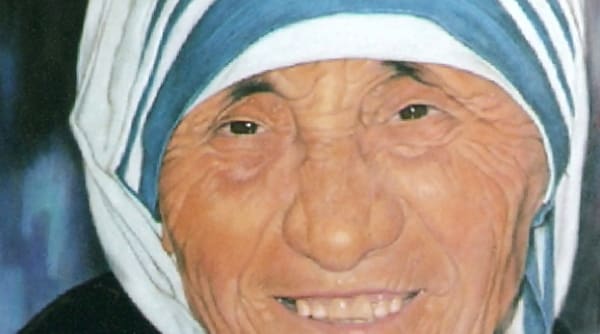To Satiate the Thirst of Jesus
Editor’s Note: Dr. Anthony Lilles gives us a lot to consider during these hot summer months, especially for those of us who live with and/or serve the sick, suffering and dying.
When we begin to pray, we implicate ourselves in the plight of others, especially those who are suffering. Prayer binds us to offer a cup of cold water to those who are thirsting because prayer allows us to suffer the thirst of God, His divine passion for the salvation of souls. In this way, prayer disposes us to see Jesus in those who are suffering, especially those who most need a reason to hope. If we allow ourselves to be vulnerable to the thirst of Christ, we realize how precious it is to offer our sufferings and to help others offer their own sufferings to satiate that thirst.
 Mother Teresa believed that many of the sick and suffering would be sanctified much faster “if they suffered to satiate the thirst of Jesus.” She had a deep conviction that Jesus was thirsty for souls, that this is the reason when He suffered on the Cross, He uttered the words “I thirst.” She had these last words of Christ put behind the altar and near the crucifix of every chapel where the Missionaries of Charity lived and served. When I am honored to pray in one of their chapels, these words are not only a reminder, but also a heart-piercing correction, love’s rebuke in the face of my own sluggishness and indifference. In many ways, these words signify the sacred purpose of Mother Teresa and the Missionaries. [Saint] Teresa of Calcutta also implicated all those these Missionaries served in this great task, especially severely ill and dying.
Mother Teresa believed that many of the sick and suffering would be sanctified much faster “if they suffered to satiate the thirst of Jesus.” She had a deep conviction that Jesus was thirsty for souls, that this is the reason when He suffered on the Cross, He uttered the words “I thirst.” She had these last words of Christ put behind the altar and near the crucifix of every chapel where the Missionaries of Charity lived and served. When I am honored to pray in one of their chapels, these words are not only a reminder, but also a heart-piercing correction, love’s rebuke in the face of my own sluggishness and indifference. In many ways, these words signify the sacred purpose of Mother Teresa and the Missionaries. [Saint] Teresa of Calcutta also implicated all those these Missionaries served in this great task, especially severely ill and dying.
What does it mean for the sick and suffering to be sanctified? Somehow when we offer our suffering to satiate the thirst of the Lord, we make space for God to work in new ways in our own life and in the lives of others. In fact, the sacrament of the anointing of the sick effects this mysterious reality in the lives of the suffering so that, in their weakness and helplessness, they are established in the very mystery of the Cross, a place of great intimacy with Christ. It is a place of such great intimacy that the Lord allows the suffering soul to extend His saving mystery through their suffering in space and time to the degree that they bear their infirmities with faith and love for His glory. It is faith and love that transforms suffering into something beautiful for God so that even suffering reveals the holiness of the Lord in the world.
 Today, in hospitals and in hospices, sometimes in households and sometimes all alone, there are those who are overwhelmed by pain and helplessness. Sometimes they are also enveloped in the most disturbing question, and this even to the point of suffering extreme temptations to despair despite their love for the Lord and desire to be holy. There are not many souls in our culture who would dare to accompany the sick through this agony, an agony that thirsts for hope. Yet entering deep into prayer, into intimacy with Christ crucified, does not allow us to ignore this plight. It was specifically into this pain that Mother Teresa directed her words “if they suffered to satiate the thirst of Jesus.” If we understand the great mystery her words point to, they can become a cup of cold water, a little hope when hope is most needed so that something beautiful might be done for God.
Today, in hospitals and in hospices, sometimes in households and sometimes all alone, there are those who are overwhelmed by pain and helplessness. Sometimes they are also enveloped in the most disturbing question, and this even to the point of suffering extreme temptations to despair despite their love for the Lord and desire to be holy. There are not many souls in our culture who would dare to accompany the sick through this agony, an agony that thirsts for hope. Yet entering deep into prayer, into intimacy with Christ crucified, does not allow us to ignore this plight. It was specifically into this pain that Mother Teresa directed her words “if they suffered to satiate the thirst of Jesus.” If we understand the great mystery her words point to, they can become a cup of cold water, a little hope when hope is most needed so that something beautiful might be done for God.
Editor’s Note: For more of Anthony’s insights on prayer, don’t miss his book, Hidden Mountain Secret Garden, an experience like no other. Anthony has an unusually profound understanding of mystical theology and lives a life of deep prayer. Among his many accomplishments and responsibilities, Dr. Lilles now teaches theology for the Avila Institute.
+
Art: Modification of “J’ai soif.” Le vinaigre donné à Jésus (“I Thirst”: The Vinegar Given to Jesus), James Tissot, between 1886 and 1894, PD-US; Mother Teresa of Calcuta [sic], portrait painting by Robert Pérez Paulou, 1 January 1994, CC; both Wikimedia Commons.





